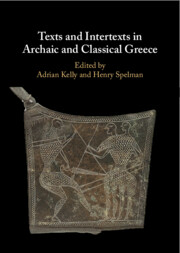Book contents
- Texts and Intertexts in Archaic and Classical Greece
- Texts and Intertexts in Archaic and Classical Greece
- Copyright page
- Contents
- Illustrations
- Tables
- Acknowledgements
- Contributors
- Abbreviations
- Introduction
- Part I Early Intertextuality
- Part II Lyric and Epic
- 4 Sappho’s Intertextual Geographies
- 5 Invoking Homer
- 6 Pindar, Bacchylides, Archaic Epic, and Intertextuality
- Part III Drama
- Part IV Conceptual Contexts
- Bibliography
- Index Locorum
- Index Rerum
4 - Sappho’s Intertextual Geographies
from Part II - Lyric and Epic
Published online by Cambridge University Press: 14 November 2024
- Texts and Intertexts in Archaic and Classical Greece
- Texts and Intertexts in Archaic and Classical Greece
- Copyright page
- Contents
- Illustrations
- Tables
- Acknowledgements
- Contributors
- Abbreviations
- Introduction
- Part I Early Intertextuality
- Part II Lyric and Epic
- 4 Sappho’s Intertextual Geographies
- 5 Invoking Homer
- 6 Pindar, Bacchylides, Archaic Epic, and Intertextuality
- Part III Drama
- Part IV Conceptual Contexts
- Bibliography
- Index Locorum
- Index Rerum
Summary
This chapter focuses on Sappho’s engagement with epic, by focusing on the appeal and significance of her songs for audiences beyond Lesbos. The argument is in three parts. First, it demonstrates that Lesbos was famous for its women and its songs also independently of Sappho: her songs helped to increase the reputation of her native island by revealing exactly what went into the making of its glamorous women. In fragments 98, 44, and several others, we see lovely women and precious goods crossing the sea and causing great delight on arrival – or disappointment when they fail to materialise. Likewise, Sappho’s own songs must have travelled overseas causing pleasure and, simultaneously, increasing the value of Lesbian exports, including women (whether they travelled overseas as brides or upmarket courtesans). Second, this chapter observes that, in both Sappho and Alcaeus, heroic characters drawn from the Trojan saga are always involved in travelling and getting married. Finally it makes the point that, in Sappho’s extant fragments, intertextual engagements with epic work primarily by superimposing the itineraries of people dear to her onto the routes traced by heroes and heroines in their own journeys of homecoming and homemaking.
Keywords
- Type
- Chapter
- Information
- Texts and Intertexts in Archaic and Classical Greece , pp. 97 - 117Publisher: Cambridge University PressPrint publication year: 2024

